8 Best Drones with Return to Home (RTH) Feature
Drones are more than just toys. When they get large enough and when flown in crowded areas, they can easily become hazardous objects. For this reason, drones are now being designed with a focus on safety, whether it’s for the drone itself, the pilot, the onlookers, and any critical infrastructures in its surroundings.
One of the best safety features you can get for your drone is a return to home function. This makes it almost impossible for you to lose your drone, even if the signal between the drone and the transmitter drops out. What are the best drones available today that offer this return to home feature? Check out our list of the best eight.
What is a return to home feature and why do you need it?
A return to home (RTH) feature gives the drone the capability to automatically return to a designated landing point which can be triggered under specific conditions. The drone pilot may set the RTH location as either the takeoff spot or the location of the remote controller.
The RTH function may be triggered by one of three ways:
- The pilot returning the One-Key Return button. Take note that this function is typically featured in cheap drones that have no GPS function. In such cases, this is not a true RTH feature – it merely attempts to retrace the flight path it took to find its way back to you. The accuracy of this “pseudo-RTH” is often questionable.
- Loss of signal between the drone and the remote controller. This is the most common and useful way of triggering the RTH. Once the drone passes a time threshold when it does not receive any signals from the remote controller, it automatically makes its way back to the designated landing location. This prevents drone flyaways, allowing you to recover your drone even if you can no longer control it manually.
- Drones with “smart” batteries have a system for estimating how much battery will be needed for the drone to make its way back to the RTH position. Should the battery reach the minimum level needed for the return trip, the RTH function will be triggered to ensure that the drone can be recovered. This is not a common feature.
Aside from the option of setting a landing option, drone operators can also set the altitude at which the drone will fly as it flies on the return trip. This allows you the drone to avoid near-ground obstacles such as trees and power lines.
The top 8 best return to home drones
1. DJI Mavic Air

Even though the Mavic Air has been around for more than two years and has since been overshadowed by newer drones under the DJI Mavic line, it remains fairly popular. The Mavic Air was one of the first ultra-portable drones to come with a 4K camera and is still one of the more inexpensive options at less than $1000.
At the time of its release, the Mavic Air was the lightest, smallest, and cheapest of the DJI Mavic drones. It’s a marvel of engineering that surprised a lot of people because of how much technology DJI was able to fit into such a small and lightweight drone. There’s also the fact that the Mavic Air came with an obstacle avoidance system that was superior to the original Mavic Pro, although DJI was not able to perfect the technology until the later Mavic iterations.
With the onboard GPS technology, the Mavic Air was capable of automated flight including a true RTF function. Using a slider, you can easily set the altitude at which the drone will fly when RTH is triggered. The drone’s GPS module is very accurate, so the drone should find its way back to the designated landing point with minimal error.
The battery life of the Mavic Air is a paltry 21 minutes under ideal conditions, which is one of its few weak points. While it’s not a drone that will be useful for professional needs, it’s still a compelling choice for beginners who are willing to spend a bit more to get a high-quality model for their very first drone.
2. DJI Mavic 2 Pro
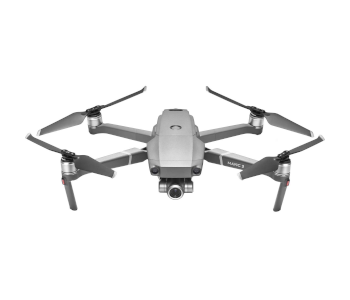
Jumping from the hobby-grade Mavic Air to the Mavic 2 Pro is a huge leap. After all, the Mavic 2 Pro is among the best drones that DJI has created and currently stands near the front of the pack of the Mavic line. This is a professional-grade drone with professional-quality features. Its price has dropped since it was released more than a year ago and now costs close to $1500.
The Mavic 2 Pro still holds the distinction as being one of the best ultra-portable camera drones. With its Hasselblad camera with a 1-inch CMOS sensor, it can capture 4K videos at 30 fps and 20 MP stills. It has a wide ISO range and a more extensive color profile, allowing you to capture vibrant photos even in low-light conditions.
The Mavic 2 Pro is the first Mavic drone to feature an omnidirectional obstacle avoidance system. This could prove useful for any automated drone flight protocols, including the RTH function. There might be little need for the RTH function, though, because the Mavic 2 Pro has been outfitted with DJI’s premium OcuSync 2.0 transmission technology and has a 31-minute battery life.
If there’s a drawback to the Mavic 2 Pro, it’s the fact that it’s still very expensive for an ultra-portable drone. However, it’s still worth every dollar. The Mavic 2 Pro is widely considered to be the best ultra-portable camera drone and no worth competitor has come out yet.
3. Autel Evo

The Autel Evo was released two years ago as Autel’s answer to the DJI Mavic Pro. This bright-orange drone is one of the most popular competitors to the DJI Mavic line of ultra-portable drones.
As a camera drone, the Autel Evo is an above-average option. It can shoot 4K video at smooth 60 fps, has a 3-axis gimbal, and offers a limited array of camera modes. The Ambarella H2 image processor, the Autel Evo camera has a wide dynamic range that can capture a greater variety of vibrant colors.
The included remote controller comes integrated with a 3.3-inch OLED touchscreen, which is a nice touch since it means that you don’t need to use your phone to fly this drone. As with the drone, the level of craftsmanship of the remote controller is almost perfect.
The dual GPS-GLONASS sensor of the Autel Evo allows it to maintain a stable hover even without active user input. It’s also the technology behind the drone’s RTH function. The accuracy of the RTH function isn’t stellar, but it’s not so bad that you’ll be turned off using it.
At about $900, the Autel Evo is quite inexpensive although you can probably get a much better ultra-portable drone for a few hundred dollars more.
4. DJI Mavic Mini
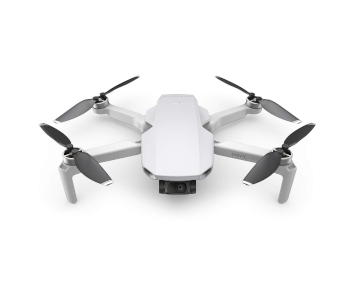
One of the more recent offerings from DJI, the Mavic Mini flies just right below the weight threshold that requires FAA registration. This is perfect for recreational drone pilots who just want to fly their drones without the complications of having to deal with the FAA.
The Mavic Mini is an incredibly small and lightweight drone and is the smallest of the DJI Mavic family. Despite the size, the drone has a three-axis gimbal, although its camera resolution is limited to 2.7K. The camera is complemented by the usual camera modes found in DJI drones, although more advanced features such as a Follow Me mode are unsurprisingly absent.
Despite the size, the Mavic Mini has dual GPS-GLONASS sensors that give it the standard RTH function. Activating RTH is easy settings its parameters can be quickly done through the DJI GO mobile app. The Mavic Mini can fly for an impressive 30 minutes before its battery needs to be replaced.
On top of the portability and an impressive set of features, the strong point of the Mavic Mini is its price. The base drone only costs around $400, while you can get the Fly More bundle for an additional $100. This is one of the best cheap drones you can get and is likely the best one in this price range.
5. Yuneec Typhoon H Pro
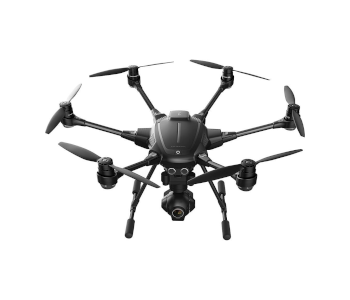
One look at the Yuneec Typhoon H Pro and you know that it means business. This hexacopter is one of Yuneec’s banner models and has all the trappings of a professional-grade drone. It’s sleek, minimalist, and huge – this isn’t the type of drone you would want to walk around with.
The Yuneec’s peculiar design allows it to have a retractable landing gear, providing 360 degrees of visibility to the drone’s camera. The camera is similarly impressive. It can record 4K videos and 12 MP images and boasts of super-smooth footage via the three-axis mechanical gimbal.
The standout feature of the Typhoon H Pro is the Intel RealSense obstacle avoidance system. This technology uses an array of optical sensors to create a model of its surroundings, allowing the drone to automatically generate a flight path that steers clear of all obstacles. This is one of the most advanced obstacle avoidance systems found in drones up to this day.
The RTH function of the Typhoon H Pro can be set to designate the take-off point as the landing point or have a more dynamic landing point which is just a few feet away from the current location of the remote controller. The feature works smoothly and accurately pinpoints the location of the controller, even if you’ve moved a good distance away from the takeoff point.
6. DJI Spark

The Spark was the original casual-use drone from DJI. The Spark remains one of their smallest and lightest drones, although it lacks the foldable propellers arms that have made the DJI Mavic line very portable. It’s also an old model, so you could probably get one nowadays for less than $500.
The age of the Spark really shows when you look at its specs: it has a 1080p camera mounted on a 2-axis mechanical gimbal. Its maximum flight time is a paltry 16 minutes while its control range is limited to 1.2 miles. Compared to most of the drones available today, these specs seem underwhelming. Just to put this observation into context, the Spark was released almost three years ago.
Still, there are a lot of things that make the Spark as appealing now as it was back then. It was the first DJI drone to feature the Gesture mode, which allowed for selfie-style drone photos. It also has an object detection system, albeit a basic one.
Beginners will be glad to know that the Spark has the RTH function found in higher-end DJI drones. This means that you don’t need to stress too much about your battery running out mid-flight, something that’s admittedly highly probable.
7. Hubsan X4 H501S-S Pro Version
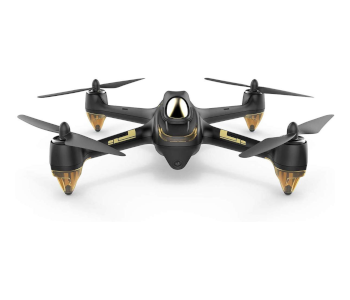
If all you’re after is a drone that has an RTH function, then you don’t need to spend a lot on the latest and greatest models. The X4 H501S-S Pro from Hubsan has an elegant black and gold design that belies its less-than-$200 price tag.
The H501S-S Pro has a 1080p HD camera, brushless motors, and a six-axis gyro. It also has a host of features geared towards beginners including a Headless Mode, Follow Me Mode, and an Auto Altitude Hold. The Automatic Return function can be triggered if the drone loses the signal from the remote controller or if the drone’s battery level goes below an established threshold.
Surprisingly for such an inexpensive drone is the fact that the H501S-S comes with a remote controller with an integrated 4.3-inch LCD screen. This is convenient since you no longer need to use your phone as a receiver for the drone’s real-time video feed.
All its merits aside, the X4 H501S-S is no more than a hobby drone. It’s great for flying for fun and for capturing videos for sharing online, but they won’t be at a level of quality that’s anywhere near good enough for professional use.
8. Altair Aerial AA300 GPS Beginner Drone
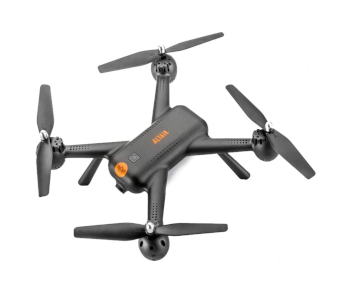
The AA300 drone from Altair Aerial is another good option for a beginner-friendly drone that offers an RTH feature. As expected, this is a pretty inexpensive drone that you can get for around $150.
The camera of the AA300 drone can capture 1080p videos, which is perfect for sharing aerial videos online. With one-touch takeoff and landing buttons and Auto Altitude Hold, the AA300 is very beginner-friendly. Its RTH function can be triggered in three ways: manually, by low battery level, and by loss of controller signal.
The AA300 has a modest range of 150 meters and flight time of 15 minutes. The flight time may seem underwhelming, so you might want to consider getting a spare battery should you get this drone.
This is a fairly intuitive and durable drone that is very easy to fly, even for those with no experience flying drones. However, the lack of any image stabilization makes the videos shot with this drone practically useless when it’s windy outside.
Final thoughts
A Return to Home (RTH) function is a massively useful feature for drones, especially in the context of safety. Losing a drone because of a flyaway is one of the worst things that can happen to you as a drone pilot. It can also happen suddenly, especially if you’re flying in areas with large obstacles or electrified structures.
The good news is virtually all modern drones now come with an RTH function. From cheap ones made for hobby flight to the more expensive, high-end models, losing a drone due to a flyaway is no longer as serious of a problem. It also makes it easier to recover your drone when you’re just too tired to fly it back yourself.

